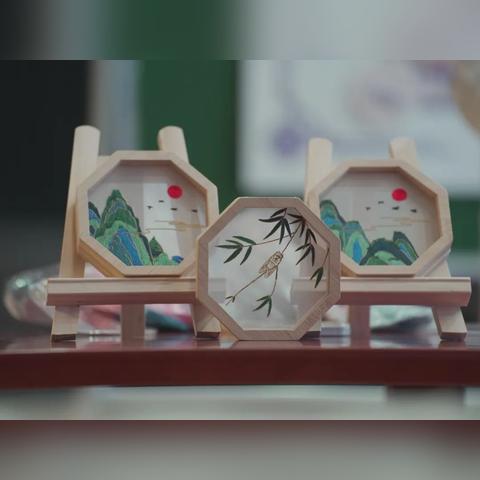The Global Fabric of Innovation:Designing Textiles with a Planet in Mind
Introduction: In the realm of fashion, textiles have always been more than just clothing; they are a reflection of our culture, an expression of our values, and a canvas for creativity. As we strive towards sustainability and environmental consciousness, it's crucial that we design textiles that not only look good but also be good for the planet. This talk will explore how designers can incorporate principles of sustainability into their work, using examples from around the world to illustrate innovative solutions.

Sustainable Textile Design: A Global Commitment
Textile design has evolved beyond mere aesthetics; it now encompasses the use of eco-friendly materials, energy-efficient production processes, and end-of-life management strategies. The global textile industry is at the forefront of these changes, driven by both consumer demand and regulatory pressures.
-
Renewable Materials:
- Transitioning from synthetic to natural fibers like cotton, linen, hemp, and organic wool.
- Embracing recycled polyester and nylon.
- Using biodegradable dyes and finishes.
-
Energy Efficiency:
- Reducing water usage through advanced printing technologies.
- Optimizing dyeing and finishing processes for energy efficiency.
- Providing information on the carbon footprint of each product.
-
Lifecycle Analysis (LCA):
- Conducting LCA studies to identify areas where improvements can be made.
- Developing products that have a longer lifespan and reduced waste.
- Implementing recycling programs to minimize waste.
-
Sustainable Packaging:
- Using recyclable or compostable packaging materials.
- Encouraging customers to reuse or repurpose packaging.
- Investing in sustainable shipping methods like electric vehicles or biofuels.
-
Education and Advocacy:
- Educating consumers about the importance of sustainable textiles.
- Partnering with organizations to raise awareness about the impact of textile production.
- Supporting fair trade practices to ensure workers' rights are respected.
Case Study: The Rise of Organic Fashion
One such example is the rise of organic fashion, which has seen a surge in popularity due to its commitment to ethical and sustainable practices. Brands like Patagonia, Everlane, and Theory have become leaders in this movement, offering products made from organic cotton, hemp, and other natural fibers. These brands not only prioritize sustainability but also advocate for policies that protect workers' rights and promote fair trade.
Another example is the use of recycled polyester in fashion, which has gained traction in recent years. By utilizing recycled materials, designers can reduce the environmental impact of new fabric production while also creating stylish and functional garments.
Conclusion: The future of textile design lies in embracing sustainability and innovation. By incorporating these principles into our designs, we can create products that not only look good but also contribute to a healthier planet. As we continue to evolve as a society, the role of textile designers will become increasingly important in shaping our collective consciousness about the environment. Let's embrace this responsibility and inspire others to do the same.
随着全球化的快速发展,人们对环保和可持续性越来越重视,在这样的背景下,围绕地球设计纺织品成为一种趋势,本文将探讨如何通过纺织品的设计和制造,实现地球的可持续发展,我们将通过英文案例说明来进一步阐述这一主题。
地球主题在纺织品设计中的应用
环保材料选择
在纺织品设计中,选择环保材料至关重要,我们可以从以下几个方面考虑:
(1)可再生资源:利用如竹纤维、麻纤维等可再生资源,减少对环境的破坏。
(2)可持续纺织技术:采用生物降解材料、可回收材料等,降低废弃物的产生。

(3)绿色染料和染色工艺:使用环保染料和绿色染色工艺,减少化学污染。
生态友好设计
生态友好设计是纺织品设计中不可或缺的一部分,我们可以从以下几个方面考虑:
(1)减少浪费:通过优化产品设计,减少不必要的浪费,降低资源消耗。
(2)循环利用:利用旧纺织品进行再利用,减少资源的浪费和环境污染。
(3)绿色包装:采用环保包装材料,减少环境污染和资源浪费。
英文案例说明
以某知名品牌为例,展示如何围绕地球设计纺织品,该品牌在纺织品的设计和制造过程中,充分考虑了环保和可持续性因素。
材料选择
该品牌主要采用天然纤维作为原材料,如竹纤维、麻纤维等,这些天然纤维不仅环保,而且具有良好的吸湿性、透气性和舒适性,该品牌还注重使用可回收材料,减少废弃物的产生。
生态友好设计
该品牌在产品设计过程中,充分考虑了生态友好性,该品牌的产品包装采用了可降解材料,可以循环利用;在染色工艺方面,该品牌采用了环保染料和绿色染色工艺,减少了化学污染,该品牌还注重产品的循环利用,通过回收旧纺织品进行再利用。
围绕地球设计纺织品是可持续发展的必然趋势,我们可以从以下几个方面进一步推动这一趋势:
-
加强政策支持:政府应加强对纺织品设计和制造的监管和政策支持,鼓励企业采用环保和可持续性材料和技术。
-
推广绿色消费理念:通过宣传和教育,推广绿色消费理念,让更多的人了解并参与到环保和可持续性纺织品的使用中来。
-
创新纺织品设计和技术:鼓励企业和研究机构不断创新纺织品设计和技术,提高纺织品的质量和环保性能。
围绕地球设计纺织品是可持续发展的必然趋势,通过选择环保材料、优化产品设计、推广绿色消费理念、创新纺织品设计和技术等措施,我们可以实现地球的可持续发展,我们也可以通过英文案例说明的方式,进一步了解如何将这一主题应用到实际生活中。
Articles related to the knowledge points of this article:
The Determining Factors of Textile Oil Content
Kitchen Textiles and Their Impact on the Cooking Experience
The Expanding Horizons of Textiles in Modern Society
Blue Dream Textiles:A Journey Through Quality and Innovation
Embracing Innovation in Textiles:The Story of Jinde Noble Textiles
Exploring the Art of Salt Texture in Home Textiles:An Idealized Journey



